唐代筆記 vol.42 富士美術館:加彩騎馬婦人俑,對比安宅收藏婦人俑、鷹匠俑 - Fuji Art Museum, Painted Pottery Figurine of Woman on Horseback, Tang Dynasty
- SACA

- Aug 18
- 10 min read
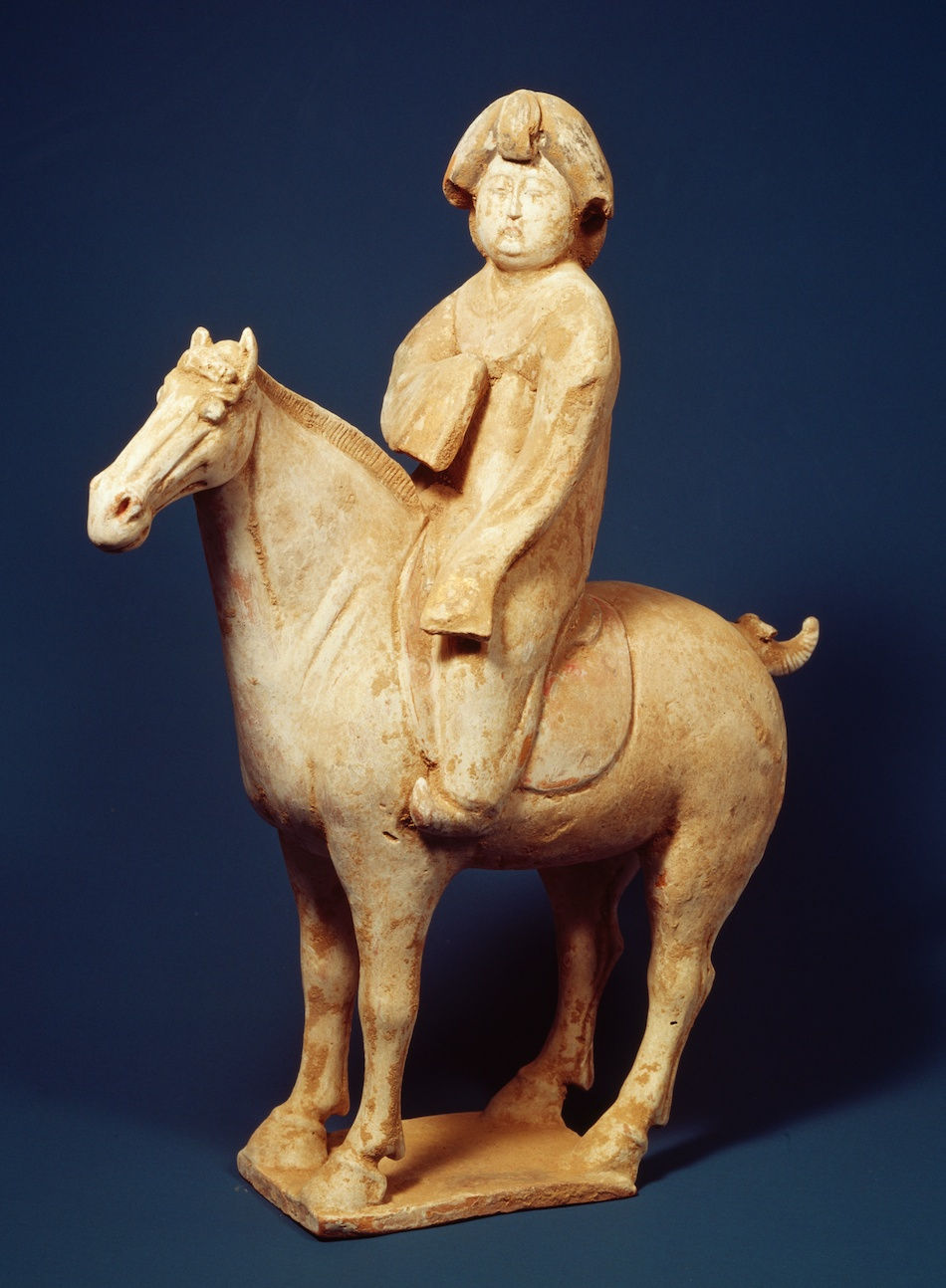
此類「加彩騎馬婦人俑」存世較為罕見。一般唐代騎馬俑多著重於馬體結構與動勢的表現,而本件將視線重心明確回歸於騎乘者本身:髮式、衣褶、姿態以及面相均經細緻塑繪,顯示人物形象才是敘事核心。
為便於斷代與風格比勘,可參考大阪市立東洋陶瓷美術館(住友集團捐贈,安宅收藏)所藏兩件同類:其一為「加彩騎馬女俑」,其二為「加彩騎馬鷹匠俑」。二者與本件在尺度、釉彩殘留、人物塑造之成熟度上均相近,極可能反映盛唐一脈共通的審美取向。
富士美術館 本件
加彩騎馬婦人俑
唐(8世紀前後)/高 36.5 cm本俑以素胎加彩示人,騎姿端穩,神情沉著。女俑面廓豐圓而不失清朗,髮式高聳,衣襟層疊處以彩料強調轉折;馬體比例勻稱,四肢收放得宜,為盛唐人像題材主導而馬具簡化的代表性作品。
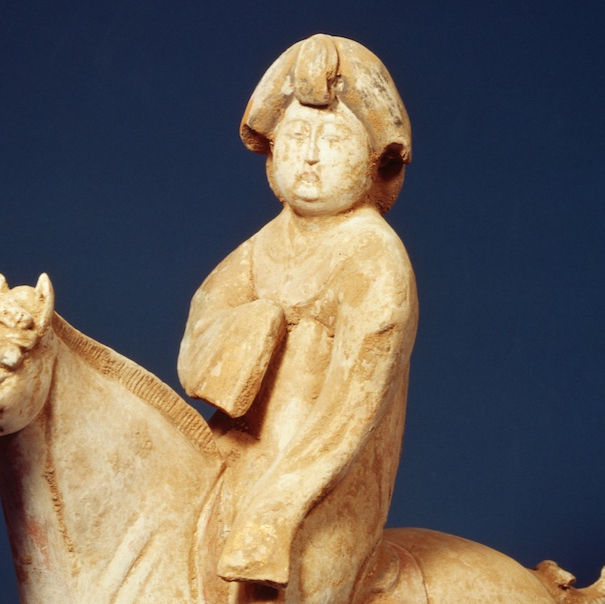
參考例一(安宅收藏)
加彩騎馬女俑
唐時代・8世紀/高 37.0、長 30.4、幅 16.6 cm
住友グループ寄贈(安宅コレクション)/大阪市立東洋陶瓷美術館藏
長安(今西安)為國際都市,受西亞等「胡風」影響,盛唐流行女子著胡服、甚至男裝及騎乘。
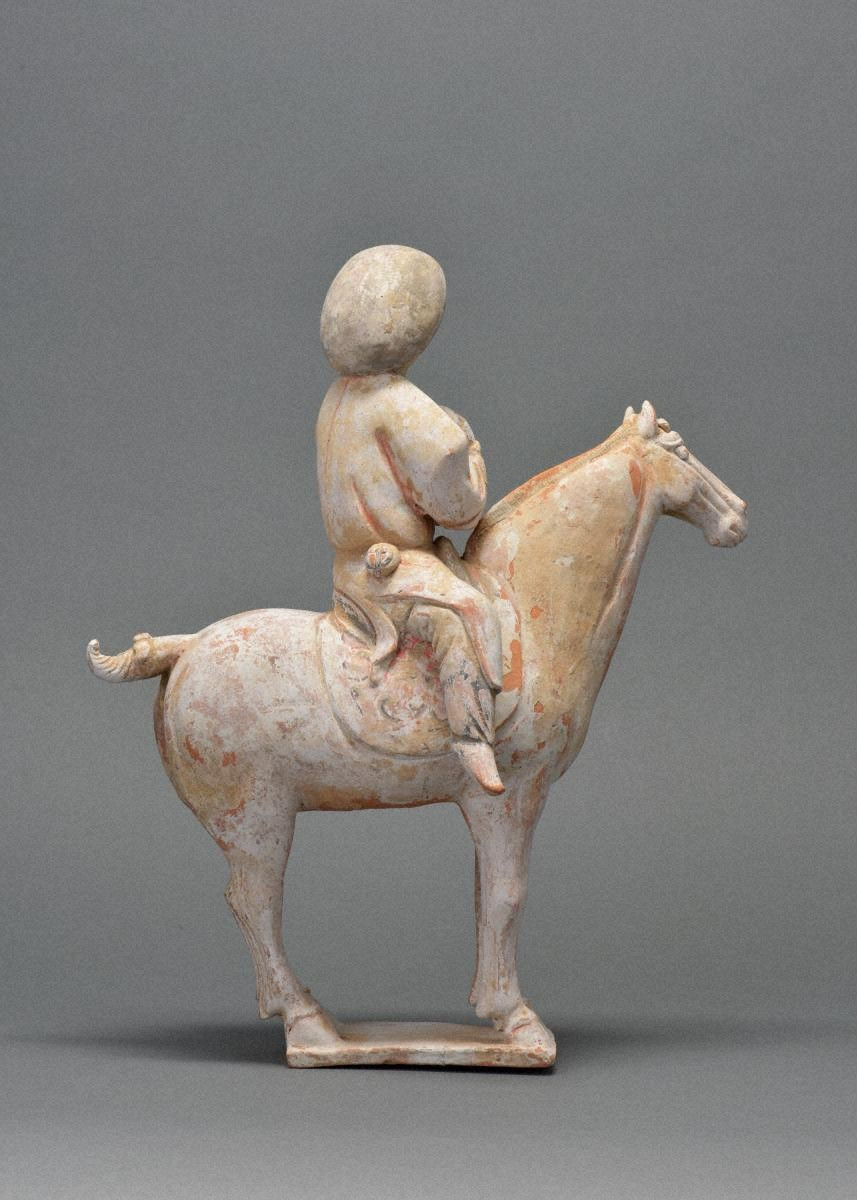
本件為騎馬女俑之佳作,與西安出土開元十二年(724)「金鄉縣主墓」作例相近,故大體可歸於同時期,屬玄宗「開元之治」盛世之產。
傳為岩崎家舊藏。其髮式與「穆泰墓」出土一件加彩女俑相類,但本件髮量更為蓬鬆;面形愈趨豐腴,然承武后以降之審美,身段未至極度飽滿。
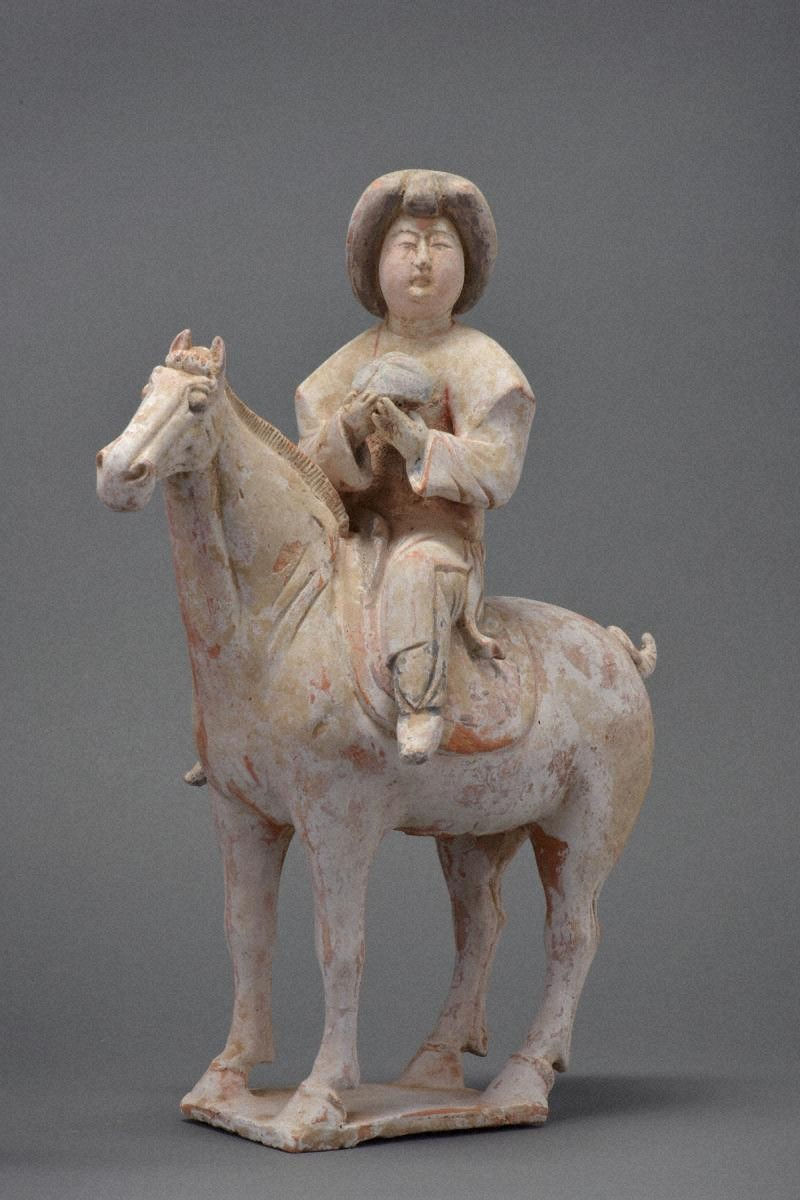
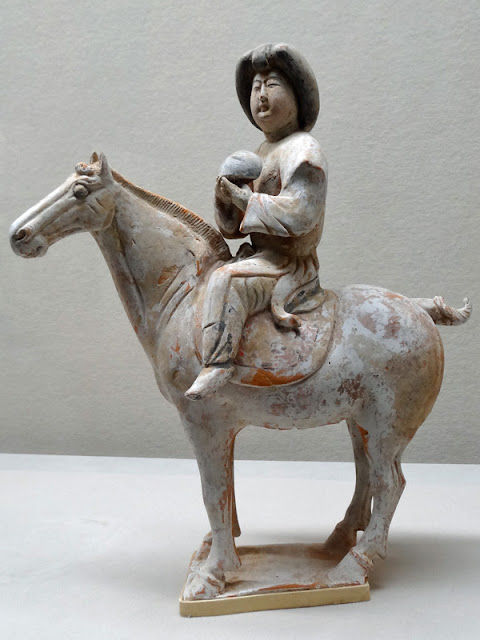
參考例二(安宅收藏)
加彩騎馬鷹匠俑
唐時代・8世紀/高 37.0、長 31.0、幅 15.8 cm
住友グループ寄贈(安宅コレクション)/大阪市立東洋陶瓷美術館藏
與前述騎馬女俑同手同風,極可能原屬一組。頭戴鷹冠,右手鷹立,其口唇抿成「へ」字,見緊張神態;面部豐潤與女俑相通,顯盛唐開元年間(713–741)人物塑形之成熟。
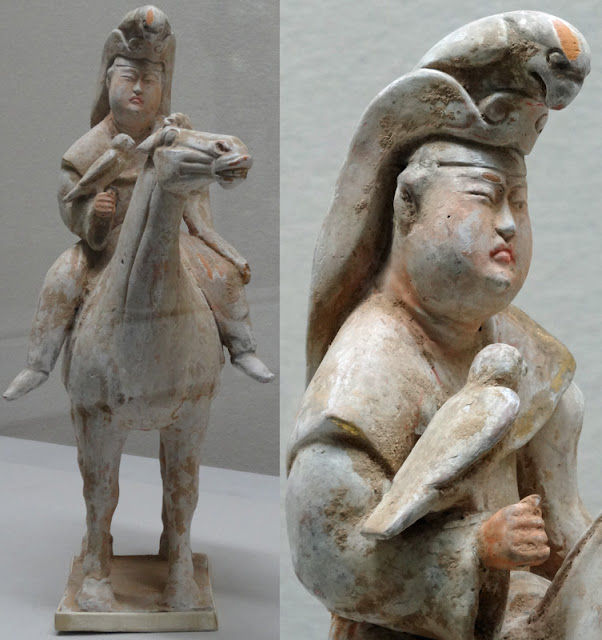
衣飾局部存貼金(金彩)痕跡,顯示原有鮮麗彩飾;此貼金位於衣領等部位,與「穆泰墓」女性俑之用法相合。原以為女鷹匠,後更正為男性形象;與上一件相比,雙頰較平,下顎肉感更著。右目似閉,左目遠眺,神情專注。
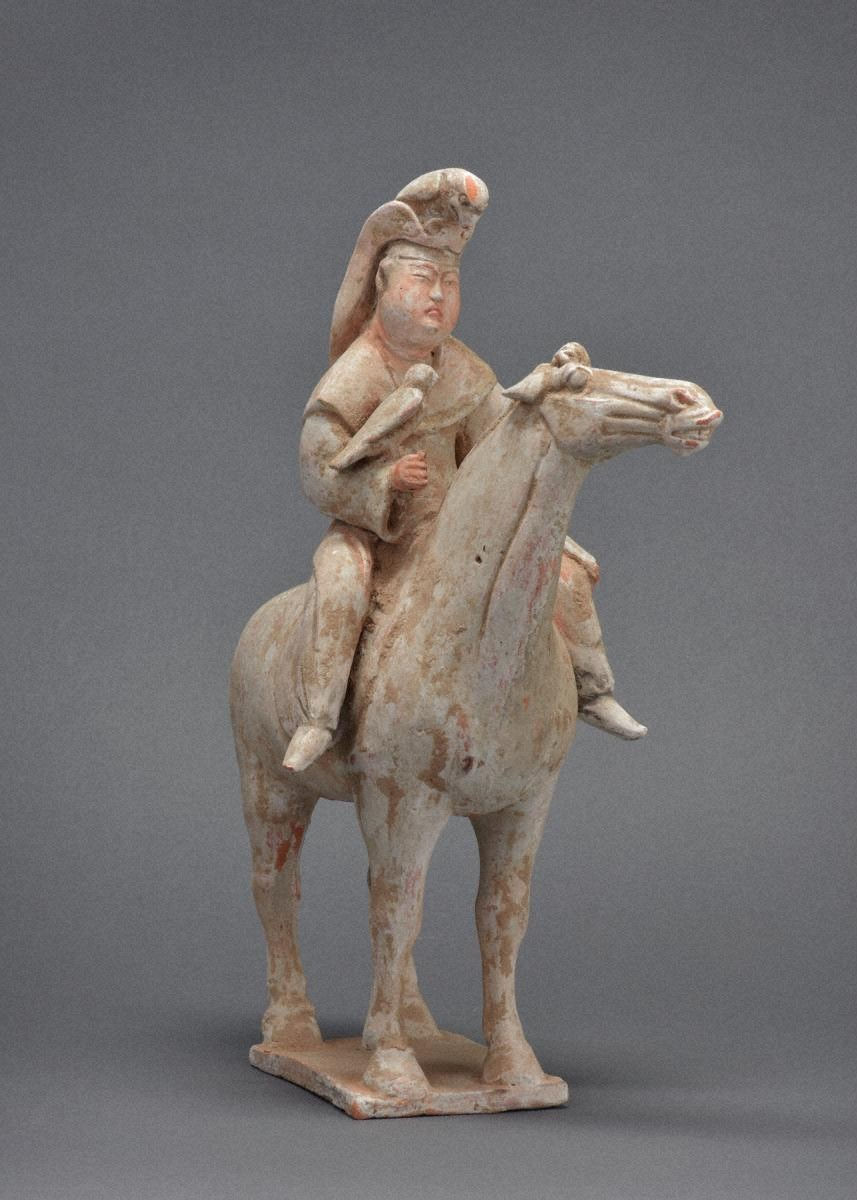
唐代騎馬俑收藏常見問題
1. 本文主要討論哪些類型的唐代俑?
本文主要討論唐代「加彩騎馬俑」,特別是東京富士美術館收藏的一件「加彩騎馬婦人俑」,以及大阪市立東洋陶瓷美術館(安宅收藏)的兩件比較作例:「加彩騎馬女俑」和「加彩騎馬鷹匠俑」。這些俑的共同特點是注重騎乘者本身,而非僅限於馬體。
2. 東京富士美術館的「加彩騎馬婦人俑」有何獨特之處?
東京富士美術館的「加彩騎馬婦人俑」獨特之處在於它將視線重心明確回歸於騎乘者本身。與一般唐代騎馬俑多著重於馬體結構與動勢不同,此件作品在髮式、衣褶、姿態以及面相上均經細緻塑繪,顯示人物形象才是敘事核心。其馬體比例勻稱,馬具簡化,是盛唐人像題材主導的代表性作品。
3. 安宅收藏的兩件騎馬俑與富士美術館的婦人俑有何關聯?
安宅收藏的「加彩騎馬女俑」和「加彩騎馬鷹匠俑」與富士美術館的婦人俑在尺度、釉彩殘留以及人物塑造的成熟度上均相近。它們極可能反映了盛唐時期一脈共通的審美取向,甚至「加彩騎馬鷹匠俑」與「加彩騎馬女俑」被認為是同一工房所作,極可能原屬一組。這些相似性使得它們成為富士美術館作品斷代與風格比勘的重要參考。
4. 這些騎馬俑反映了盛唐時期怎樣的社會風尚?
這些騎馬俑反映了盛唐時期,特別是玄宗「開元之治」盛世的社會風尚。當時的國際都市長安受到西亞等「胡風」的影響,因此女子著胡服、甚至男裝及騎乘在當時蔚為流行。騎馬女俑的出現,正是這種跨文化交流與時尚潮流的體現。
5. 這些俑的人物塑形風格有何共同特徵?
這些俑的人物塑形風格具有共同特徵,尤其反映了盛唐開元年間(713–741)人物塑形的成熟。面部普遍呈現豐圓(豐腴)的特點,但並非過度肥胖,這符合武后以來逐步發展的審美標準。髮式高聳且具量感,衣褶層疊處以彩料強調轉折,顯示了對細節的精確把握。鷹匠俑的表情,例如抿唇和專注的眼神,也體現了對人物神態的細膩刻畫。
6. 這些俑的年代是如何判斷的?
這些俑的年代大致被判斷為唐代8世紀前後,即盛唐時期,尤其與玄宗「開元之治」的時期(713-741年)高度相關。「加彩騎馬女俑」因其風格與西安出土開元十二年(724年)的「金鄉縣主墓」作例相近,故大體可歸於同時期。這些比較作例有助於對富士美術館藏品的斷代。
7. 關於這些俑的色彩和裝飾,資料中提到了哪些細節?
資料中提到這些俑是以「素胎加彩」的形式呈現,顯示了其原本鮮麗的色彩。特別是「加彩騎馬鷹匠俑」的衣飾局部存有「貼金」(金彩)痕跡,尤其是在衣領等部位,這表明原有非常華麗的彩飾,並且這種貼金用法與「穆泰墓」出土的女性俑相似。富士美術館的婦人俑也強調了衣襟層疊處以彩料強調轉折。
8. 「加彩騎馬鷹匠俑」的性別鑑定過程是怎樣的?
「加彩騎馬鷹匠俑」最初曾被誤認為是女性形象,但後來被更正為男性。這個判斷的依據在於細微的面部特徵差異:與「加彩騎馬女俑」相比,鷹匠俑的雙頰較平,下顎肉感更著。此外,其口唇抿成「へ」字形,見緊張神態,以及右目似閉、左目遠眺的專注神情,也可能暗示了特定職業(鷹匠)的男性特徵。
Overview and Comparanda
Painted pottery female riders of this type are relatively rare. While most Tang equestrian figures emphasize the anatomy and movement of the horse, the present example draws the viewer’s attention back to the rider herself—her coiffure, drapery, posture, and facial modeling form the expressive core.
For stylistic and chronological comparison, two closely related works in the Osaka City Museum of Oriental Ceramics (Sumitomo Group donation, Ataka Collection) are instructive: a Painted Female Rider and a Painted Falconer on Horseback. Their comparable scale, surviving pigments/metallic appliqué, and mature figural style suggest a shared aesthetic current of the High Tang.
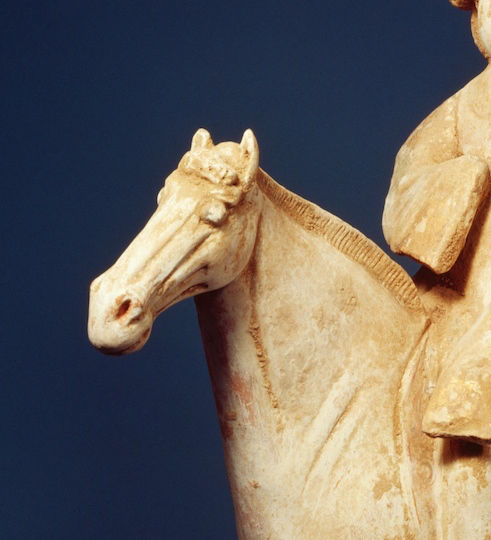
Present Work (Tokyo Fuji Art Museum)
Painted Pottery Burial Figurine of a Woman on Horseback
Tang dynasty (ca. 8th century) / H. 36.5 cm
Modeled in earthenware with polychrome, the rider sits upright with composed demeanor. The face is rounded yet clear in contour; the high, voluminous coiffure and layered lapels are accented with paint at the turning folds. The horse is proportionate and poised, its tack simplified in deference to the primacy of the human figure—typical of High Tang rider-centric compositions.

Comparandum 1 (Ataka Collection)
Painted Female Rider
Tang dynasty, 8th century / H. 37.0 cm; L. 30.4 cm; W. 16.6 cm
Sumitomo Group donation (Ataka Collection), Osaka City Museum of Oriental Ceramics
As cosmopolitan Chang’an drew peoples and fashions from West and Central Asia, so-called hufu (foreign dress), cross-dressing, and ladies on horseback became fashionable in the High Tang.
This figure is an excellent example, closely related to a rider excavated from the Tomb of the Princess of Jinxian County dated to Kaiyuan 12 (A.D. 724) in Xi’an; it is therefore likely contemporary, belonging to the flourishing reign of Emperor Xuanzong (the “Kaiyuan Prosperity”).
Formerly in the Iwasaki collection. The coiffure resembles that of a painted female figure from the Tomb of Mutai, though here it is even more voluminous; the face is fuller, yet—consistent with tastes after Empress Wu—the body is not excessively plump.
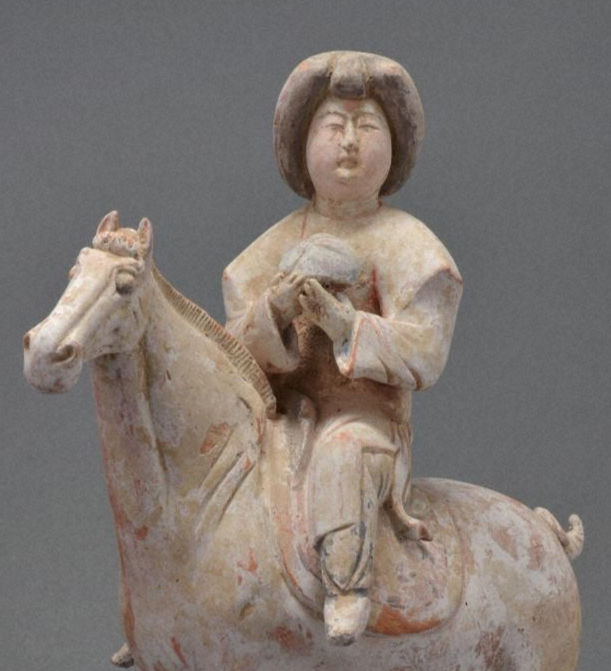
Comparandum 2 (Ataka Collection)
Painted Falconer on Horseback
Tang dynasty, 8th century / H. 37.0 cm; L. 31.0 cm; W. 15.8 cm
Sumitomo Group donation (Ataka Collection), Osaka City Museum of Oriental Ceramics
Executed in the same hand and style as the female rider and very likely part of the same group. Wearing a falconer’s cap and holding a hawk on the right hand, he presses the lips into a tense “he”-shaped line.
The full, rounded visage again reflects the mature figural idiom of the Kaiyuan era (713–741). Traces of gilt appliqué (gold paint/foil) survive on parts of the costume—especially around the collar—indicating an originally vivid polychromy, comparable to the female figure from the Tomb of Mutai.
Once thought to represent a female falconer, the figure is now read as male; compared with the female rider, the cheeks are flatter and the lower jaw fleshier. The right eye appears closed while the left fixes a sharp gaze into the distance.

What makes these particular Tang Dynasty equestrian figurines unique compared to others?
These figurines are unique because, unlike most Tang Dynasty equestrian figures that emphasize the horse's anatomy and movement, they primarily focus on the rider. The detailed sculpting and painting of the rider's coiffure, drapery, posture, and facial modeling are central to their expressive core, indicating that the human figure is the main narrative.
What characteristics define the "High Tang" aesthetic for human figures, as seen in these figurines?
The "High Tang" aesthetic for human figures in these figurines is characterized by a mature and refined style. Features include rounded yet clear facial contours, high and voluminous coiffures, and a preference for plump but not excessively corpulent figures, consistent with tastes after Empress Wu. The horse's tack is simplified to allow the human figure to dominate the composition.
How do the figurines from the Fuji Art Museum and the Ataka Collection relate to each other?
The figurine from the Fuji Art Museum and the two from the Ataka Collection (the Painted Female Rider and the Painted Falconer on Horseback) are closely related in scale, remaining pigments/metallic appliqué, and mature figural style. This suggests they share a common aesthetic current from the High Tang period and were possibly created by the same workshop or as part of the same group.
What insights do these figurines offer into Tang Dynasty fashion and societal trends?
These figurines offer insights into the cosmopolitan nature of Chang'an (present-day Xi'an) during the Tang Dynasty. Influenced by "hufu" (foreign dress) from West and Central Asia, it was fashionable for women in the High Tang to wear foreign attire, cross-dress in male clothing, and engage in horse riding. The figures reflect these trends, particularly the popularity of female riders.
What is the significance of the "Kaiyuan Prosperity" in relation to these figurines?
The "Kaiyuan Prosperity" refers to the flourishing reign of Emperor Xuanzong (713-741 AD). The Painted Female Rider from the Ataka Collection, in particular, is considered to be contemporary with this era, specifically aligning with works from Kaiyuan 12 (724 AD). This places these figurines within a period of significant cultural and artistic development in the Tang Dynasty, marked by a mature figural idiom.
What specific details about the "Painted Falconer on Horseback" led to its re-identification as a male figure?
Initially, the "Painted Falconer on Horseback" was thought to represent a female falconer. However, it was later re-identified as male due to specific facial characteristics: compared to the female rider, the falconer's cheeks are flatter, and the lower jaw is fleshier. Additionally, the intense, focused expression with one eye seemingly closed and the other sharply gazing into the distance contributes to the portrayal of a male figure engaged in the sport.
What kind of decorative elements and materials were used on these figurines?
These figurines were primarily made of earthenware and adorned with polychrome (multiple colors). Traces of gilt appliqué (gold paint or foil) have also been found on parts of the costumes, particularly around the collar of the "Painted Falconer on Horseback." This indicates that they originally featured vivid and elaborate color schemes and metallic ornamentation, similar to those found on figures from the Tomb of Mutai.
How do these figurines help in understanding the dating and stylistic evolution of Tang Dynasty art?
The detailed comparisons between these figurines and excavated works, such as those from the Tomb of the Princess of Jinxian County (dated 724 AD) and the Tomb of Mutai, are crucial for dating and understanding stylistic evolution. Their comparable scale, mature figural style, and specific features like coiffures and facial modeling allow scholars to place them within the 8th century, specifically the High Tang period and the Kaiyuan era, providing valuable benchmarks for the development of Tang Dynasty burial art.
概説と比較
この種の加彩騎馬婦人俑は現存例が少なく、唐代の騎馬俑に一般的な「馬体の線と動勢の強調」に対し、本作は騎手そのもの—髪型・衣文・姿勢・面貌—に主題を置く点に特色があります。作例比較としては、大阪市立東洋陶磁美術館(住友グループ寄贈・安宅コレクション)所蔵の加彩騎馬女俑および加彩騎馬鷹匠俑が有効で、いずれも尺度・彩色残存・人物表現の成熟度が近く、盛唐に共有された審美傾向を示します。
富士美術館 本件
加彩騎馬婦人俑
唐(8世紀頃)/高 36.5 cm
素地に彩色。騎姿は端正で、面貌はふっくらとしつつ輪郭が明晰。高く量感ある髪型、重なる衣襟の転折部に彩色が残ります。馬体は均整で、馬具表現は抑制的—人像主体の盛唐的構成を典型的に示します。
比較作例 1(安宅コレクション)
加彩騎馬女俑
唐時代・8世紀/高 37.0・長 30.4・幅 16.6 cm
住友グループ寄贈(安宅コレクション)/大阪市立東洋陶磁美術館蔵
長安は国際都市として西アジア由来の「胡風」を受容し、盛唐期には女子の胡服・男装・騎馬が流行。本作は騎馬女俑の優品で、西安で発見された開元12年(724)の金郷県主墓出土作例と近く、玄宗「開元の治」に属する同時期作とみられます。岩崎家旧蔵。髪型は穆泰墓出土の加彩俑に類似するが、本作はよりボリュームが大きい。面相は一層ふっくらするものの、武后以後の審美に沿い、体型は過度に肥満ではありません。
比較作例 2(安宅コレクション)
加彩騎馬鷹匠俑
唐時代‧8世紀/高 37.0‧長 31.0‧幅 15.8 cm
住友グループ寄贈(安宅コレクション)/大阪市立東洋陶磁美術館蔵
前掲の騎馬女俑と同一工房作の可能性が高い。一種の鷹冠をかぶり、右手に鷹を据える鷹匠で、口を「へ」の字に結び緊張を示す。ふっくらとした顔立ちは盛唐開元年間(713–741)の成熟した人物造形を物語る。衣装の一部には貼金(金彩)の痕跡が残り、とりわけ襟元の装飾は穆泰墓の女性俑と同様で、もとは彩色華麗であったことを示す。かつて女性像と解されたが現在は男性像とされ、騎馬女俑に比べて頬は平たく下顎の肉付きがよい。右眼を閉じ、左眼で遠方を鋭く見据える表現が印象的です。



































Comments